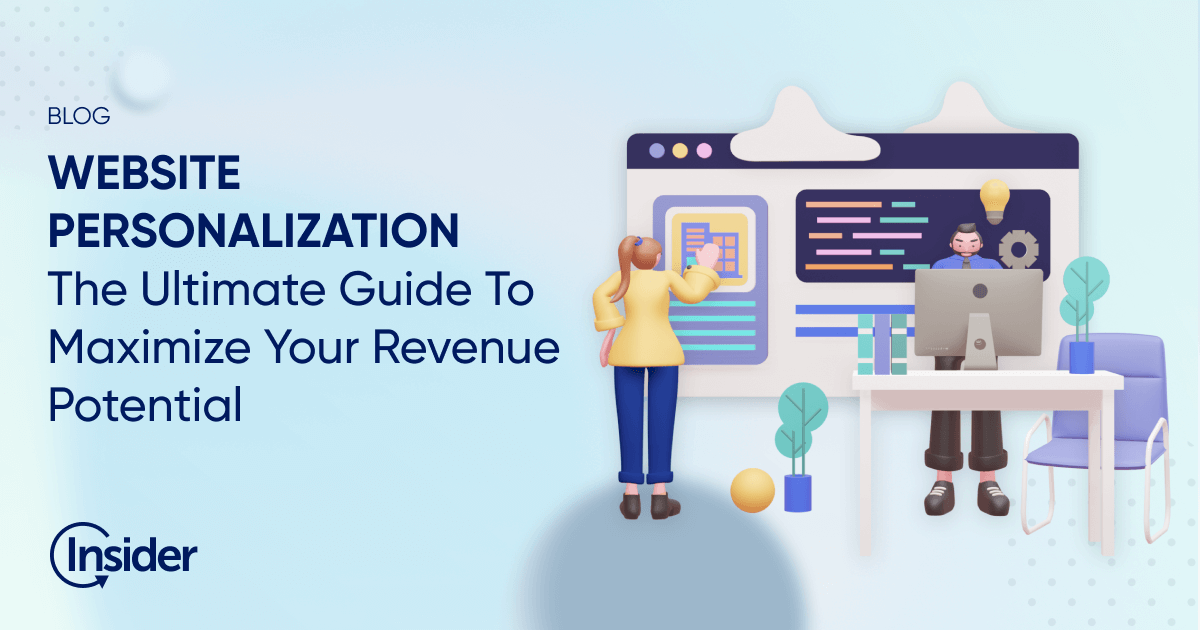Nominees Revealed: We have made it on the shortlist for 3 categories in the Mob-Ex 2019 awards thanks to our relentless drive, kick-ass team, and customers. The post Website personalization: The ultimate guide to maximizing your revenue appeared first on Insider.
Website personalization lets businesses tailor their interactions with every customers. As a result, it makes your website feel and look unique to anyone. In particular, it lets you serve different people with different needs. The benefits?
Increased sales, more engagement, and deeper loyalty.
In other words, if a customer sees what they’re looking for, they’re likely to come back.
And, you don’t have to be an IT expert or design pro to do website personalization. In fact, there are lots of easy, cost-effective ways to get started.
How to get started with website personalization
Tried website personalization? Didn’t see those efforts translate into more revenue?
Not sure where to start?
Now, let’s dive into what website personalization means (hint: it’s not about creating different websites).
What is website personalization?
In short, website personalization is creating a unique experience for each visitor according to their specific needs, interests, and preferences.
What does this mean? “Personalized” means tailoring your website or digital experience to make it relevant to each visitor—whatever their individual needs.
As a result, the type of website personalization you choose depends on the requirements of your business.
Examples include:
- Displaying targeted images or video
- Customizing product recommendations and layouts
- Adjusting how certain pages load
- Making sure customer details are captured correctly at checkout/registration
- Answering questions proactively
In truth, website personalization is about anticipating customer needs. By responding to those needs with a tailored digital experience, visitors feel valued.
Why is website personalization important?
Firstly, website personalization is an important part of providing a high-quality customer experience. Secondly, it’s key to delivering personalized content and messages that resonate with each individual visitor.
Thirdly, personalization helps visitors feel like they’re being listened to, respected, and valued.
Last, but not least, it’s important to anticipate their needs and streamline their search. In other words, drive your sales and convert one-time shoppers into repeat business.
Now, let’s examine the benefits of website personalization in more detail.
The benefits of website personalization
Strategic website personalization can bring many benefits, including:
More relevant content recommendations
However, getting irrelevant content recommendations can be annoying. It’s as if someone is trying to sell you something you don’t want or already have.
So to get the most out of website customization and keep visitors from leaving, make recommendations they’re interested in. Use the data you’ve gathered to tailor their experience and show them new and relevant products, services, or content.
Furthermore, prevent customers from leaving your website and increase the amount of time they spend there. In short, more time on your website translates to increased customer loyalty, and ultimately a higher retention rate.
The greatest example is Google. The search engine creates precise data based on a user’s browsing history, records their unique behavior, and displays content systematically fitting their interests .
Improving customer experience with website personalization
In truth, website personalization is about anticipating customer needs. It’s about delivering tailored experiences to the people who want them.
Better qualified leads
Leads that have been nurtured, segmented, and shown relevant content are more likely to enter your sales funnel.
These leads are more likely to buy from and recommend your business to others, revenue potential and customer loyalty.
Increased revenue potential
Thus, the ultimate goal of website personalization converting visitors into customers.
As a result of website personalization visitors are more likely to impulse buy. Since giving visitors what they removes friction and streamlines the path to purchase.
Improved marketing ROI with website personalization
Naturally, increased revenue potential leads to improved marketing ROI.
Of course more personalized messages, product suggestions, and content recommendations result in a better customer experience.
So now that you know the benefits of website personalization, let’s learn how to implement it.
How to personalize your website
Firstly, define your website personalization goals. But know you can’t do that without the right data.
To clarify, the more visitor data you have, the more personalized content you can create.
So, let’s dig into into the website personalization process.
Step 1: Visitor data collection
In today’s highly dynamic and customer-centric marketplace, it’s critical to attract the attention of your prospects. You can do this by gathering the right kind of data to fine-tune your marketing strategies.
Planning to personalize your website? You must consider what kind of visitor data you can collect. Next, use machine learning and predictive analysis to deliver an experience your visitors want.
Let’s explore how to gather data:
1. Ask visitors about their experience
One of the most effective ways to collect visitor data is to ask them directly. You can do this by requesting them to fill out a form.
Good times to collect this information are:
- Subscribe to a service
- Register on your platform
- Make their first purchase
You can use this opportunity to collect their:
- Name
- Gender
- Phone number
- Email address
- Location
- Industry
- Job title
- Company name, website, size, and more
By collecting this type of data, you can better understand your visitors and create a more personalized experience for them.
2. Customer journey mapping
Want to know about your customers? Start with customer journey maps.
Measure customer’s time spent on each page. Look at their interactions: how far they scroll, where they bounce, and what they click.
By observing their behavior, you’ll gain a better understanding of their interests, preferences, and actual intent. You’ll see a true picture of what your customer’s really looking for, allowing you to better serve them.
In fact, you can track how visitors interact with your campaigns. Are they opening and clicking through emails? Are they ignoring push notifications? Getting insight into these behaviors is a must for improving website personalization.
3. Cookies and web beacons
Equally, you can collect visitor data is by using cookies and web beacons. Cookies are small files that store information about visitor activity.
Web beacons are small pieces of code embedded into a page on your site. They gather statistics like how many people view it daily and which links they click on.
With these two types of data and other sources, you can get valuable insights into website user behavior. In turn, you can use this information to further personalize their experience.
4. Company records and social media
Moreover, don’t forget the value of sales records and social media.
Specifically start by examining your customer records, transaction histories, and interactions with sales and support. Next, collect data through social media and use this direct and unfiltered data to better understand your customers.
5. Email activity tracking
Email tracking is another way to learn about your customers.
You can track how many emails are opened, clicked links, when they were clicked, the number of times an email has been viewed, what time it is typically opened during the day, etcetera.
All this information helps you understand your visitors’ interests and preferences so you can better target them with personalized content.
Such data provides valuable insights into the effectiveness of different emails. Additionally, it can identify users who need more attention than others. In other words, email activity tracking offers huge potential for website personalization success.
Step 2: Visitor profiling
After collecting data, the next step is understanding how you can best serve your visitors’ needs.
First, identify your visitors’ demographics.
This includes basic personal information like their age, sex, location, occupation or industry. Apart from this, it can include details such as marital status, salary, and education.
Collecting this type of data helps you tailor the website content. You can provide them with useful and relevant information that’s aligned to their in-the-moment needs.
Second, identify your visitors’ interests.
In brief, investigate what they like on social media, their purchases, and their reviews of products or services.
First, you may be noticing many of your visitors buying a specific product or service. You see them writing reviews about it on social media sites. Clearly, they’re interested.
Next, use these insights to tailor content around their interests. Instead of showing them articles with general advice, you might want to show them more targeted posts.
Third, identify your visitors’ expectations.
This is one of the key areas where website personalization can be most beneficial.
If a visitor’s expectations are not met, it can lead to frustration. As a result, they’ll leave the site and go somewhere else.
Luckily, you have more control here than on other channels, such as social media or email marketing. Because they typically only visit one page at a time.
For example, if they know about the product or service you offer, less information is okay. If they don’t know anything about what you offer, give them more.
Lastly, identify their online behavior.
This can include browser type, devices, and at what time of day they visit your site. You’ll see patterns of activity. Some days you’ll have people from a certain country or region, other days, you may see different visitors.
For this reason, understanding how people are behaving online will help you with website personalization.
Step 3: Set your website personalization goals
In brief, identify goals for your website personalization strategy. Because having a clear goal will help you focus on the data you need to test different ideas.
Finally, let’s look at some common personalization goals:

In particular here are a few questions to think about:
- What concerns are you trying to resolve?
- What are the best ways to get your website visitors to engage with you?
- Is there a preferred language you should focus on?
- Where will your users will benefit most from your personalization efforts?
Step 4: Plan and implement website personalization strategy
After you’ve determined the goals for your website personalization strategy, it’s time to plan and implement.
How is that accomplished?
Follow the four simple steps below.

1. Identify campaigns
In the first place, you need to identify the campaigns to use in your personalization strategy. Consequently, you can
reduce bounce rates, that is, if you test different content.
In short, you can do this by giving visitors quick solutions and relevant information on your site.
Therefore, if increasing conversion rates is your main goal, show personalized product recommendations based on customers’ past purchases.
Lastly, make a list. Include:
- Tactics
- Channels
- Campaign run time
- Metrics to gauge your success
2. Prioritize campaigns
The next step is prioritizing the campaigns you identified in your plan. By doing this, you’ll make sure your personalization efforts are working towards a clear goal. One big misstep in personalization campaigns is getting distracted by secondary goals.
Be intentional and remember to ask, “how does this fit our goal?”
3. Use AI to sharpen your personalization strategy
Machine learning algorithms can scale up your personalization strategy. From basic personalization campaigns to advanced one-to-one experiences, AI can help you create more relevant and meaningful experiences.
Use AI to meet your goals and spend less time on manual personalization tasks.
4. Test and iterate
Lastly, test and iterate. After all, for your personalization strategy to be successful, it’s important you keep testing different ideas.
Don’t get stuck on one idea. Don’t try the same thing over and over again in hopes of getting a new result. Save time and resources. Stop doing what doesn’t work and continue with those driving your desired outcomes.
Step 5: Measure success
The final step is measuring success.
Success will be different for every website. Next, it’s important to define what success means before beginning the process.
Is your goal to increase conversion rates? Compare how many people bought something after viewing a personalized product recommendation vs. those who didn’t.
Want to reduce bounce rates? Compare the total time spent on the site by the visitors who view personalized recommendations vs. those who don’t. As a result, if someone views more when they’re getting personalized experiences, chances are what your doing is working.
The downside? Numbers only tell part of the story. Other factors may be impacting your results.
To conclude, make sure you’re accurately tracking the effectiveness of your website personalization efforts to ensure they produce your desired outcomes. That way, if something doesn’t work as planned, you can make changes without investing too much time.
Personalization and customization – What’s the difference?
On a whole, customization and personalization are used interchangeably. So why not use them together?
In fact, together they provide a dynamic, personalized experience that maximizes engagement and conversion rates. Second, there is a fine line separating the two methods. Let’s explore them in greater detail.
Personalization
On a whole, personalization gives visitors a one-to-one experiences. Personalization makes interactions faster and improves the odds of converting visitors into repeat customers.
In short, it’s most commonly achieved through automation. Because personalization customizes a visitor’s experience based on their previous behavior.
For instance, Spotify customizes its homepage for every user based on their previous searches. Consequently, it’s a continuous and adaptive process. Resulting from users’ changing needs and preferences.
Customization
Indeed, customization is more of a manually process. However, it provides users with greater control over the content they see.
To be sure considered more of an interactive process, as it relies heavily on the user. Because it doesn’t automatically adjust based on individual’s previous behavior.
Thus, the main benefit of customization is giving users a sense of control over what they see.
Nike By You is a great example of customization in practice.
For instance, users can select every element of their shoes, from color and style, to materials – even shoelace color.

Best practices to help you get the basics right
Now that we know the difference between personalization and customization, let’s see how to implement them at scale.
It is true companies must constantly innovate and test their strategies. As a result of testing, they can keep improving their experience and stay ahead of competitors.
So in this section, we’ve created a list of 6 best practices for personalizing your website.
1. Real-time decision making
Firstly, have real-time decision making. Doing so, ensures the experience is relevant and up to date, which improves conversions.
Amazon uses a real-time recommendation engine for its homepage. Once a visitors start typing, they’ll see recommendations based on their previous searches, popular items, or from customers viewing similar pages.
Amazon stays ahead of competition through convenience and giving shoppers better results quicker.
2. Don’t overdo recommendations
Personalization promotes the idea of showing your customers what’s most relevant to them. However, don’t irritate customers by showing them the same product or service recommendations over and over again. There is such a thing as too much of a good thing.
Allow them to explore your site beyond your recommendations. Don’t solely rely on recommendations. Look to where users are dropping off and smooth out friction.
3. Proper channeling is important
For example, not all of your website’s channels or pages work the same way in every situation.
Thus, understanding your target audience and where to deliver the right message or recommendation is critical.
Send visitors to a page that closely matches what they’re looking for. This can be your homepage, category pages, or product details.
Increase the likelihood of converting someone who is just browsing. If a visitor is has a specific product in mind, direct them to it for more revenue opportunities.
4. Test your hypothesis
Every website personalization campaign is based on a hypothesis.
Due to this, adopt a systematic and thoughtful approach. Use A/B testing to gauge your website personalization efforts.
Furthermore, testing can help determine whether your personalization efforts are on track to accomplish your goals. Otherwise, you may need to make changes to your personalization strategy.
5. Regularly monitor your analytics
Additionally, you should track the performance of your website personalization efforts using qualitative and quantitative analytical tools such as Google Analytics.
Consequently, combining quantitative and qualitative analytics, you can make more accurate predictions optimize future website personalization efforts.
6. Revisit your website personalization strategies regularly
Personalization isn’t a one-size-fits-all solution nor a “set it and forget it” strategy.
No matter how well website personalization is going, it’s important to adjust your efforts to meet your customers’ changing needs.
Regularly review your personalization strategies and make any necessary adjustments. The more innovative ideas you try, the better you’ll be able to serve your customers.
Industry website personalization examples
Because of the advantages website personalization provides, more businesses are experimenting.
Let’s look eCommerce brands are using website personalization create better customer experiences and grow revenue.
1. Ecommerce industry personalization examples
Personalization has been a very important aspect in the B2C industry in recent years. More importantly, it’s not something that customers expect. Instead, it’s something they demand.
Let’s take a look at 2 great examples:
Example #1: ASOS
ASOS is a popular eCommerce platform. It sells a wide range of clothing, accessories, beauty products, and more for men and women.
When you first visit the ASOS website, you’ll see the following homepage:

Meanwhile, if you go to the “Men” section, you’ll see a homepage focused on your most recent search. It looks something like this:

In summary, the brand ensures its visitors see what interests them the most by cookie retargeting.
Example #2: Amazon
Amazon is by far the best example of personalization. The eCommerce giant has integrated personalization into its core. See the image below:

Amazon uses a variety of personalization techniques to serve the needs of its customers including:
- Personalized product recommendations based on recent purchases and browsing
- Personalized products based on demand
- Customized website experience based on search history and browsing preferences
Amazon uses customer data to tailor the shopping experience. Thus, customers don’t have a cookie cutter experience. They’re not shown anything and everything. In fact, they see recommendations aligned with their behavior.
Consequently, this personalization technique has resulted in higher conversion rates for Amazon.
Example #3: Aesop
Aesop is an online retailer of beauty and grooming products, skincare, haircare, makeup, fragrance, and bath & body care. The brand built a loyal following by providing personalized recommendations. These were based on what their customers purchased in the past or were browsing in real time.
A customer who has dry or sensitive skin might be recommended products designed to help conditions. Another with with oily skin might receive product suggestions with mattifying and oil control formulas.

2. Travel industry personalization examples
Example #1: Booking
Booking is an excellent example of a travel site that recognizes the importance of personalization.
The site displays a recommendation widget when you log in. The widget is personalized in real time, the site makes recommendations based on their IP addresses.
Naturally, suggestions are based on the most commonly searched travel locations by people in and around their area.

Example #2: Expedia
As an example, Expedia is one of the world’s largest travel companies. It provides booking services for airlines, hotels, motels, vacation packages, and car rentals.
Furthermore, the company has made it its mission to deliver excellence in customer service. It does this by catering to every individual visitor on the site, streamlining their experience through personalization.
Geo-targeting can tell if you’re visiting from London or Tokyo and displays flights based on your IP address.
The result? Skyrocketing engagement because visitors receive relevant content without having to do anything.

3. Media & entertainment personalization examples
Online users are used to seeing content matching their interests. And, customers are more likely to stick with brands that know them by:
- Name
- Understand their needs, preferences, and tastes
- Provide content most relevant to them
Brands mastering personalization
Example #1: Spotify
It’s no secret that Spotify, the digital music service provider, has revolutionized the way media and entertainment companies think about and implement personalization.
Furthermore, Spotify personalizes playlists based on listener tastes and preferences. In particular the music streaming giant introduces new and enhanced personalization tactics to entice clients and give them options. Previously they provided customized playlists:
- Discover Weekly
- Release Radar
- Daily Mixes
Since these playlists allowed customers to enjoy their favorite music and new trending songs, Spotify grew in popularity.
Example #2: Netflix
Today we are in a race to find time for work and leisure. As a result, Netflix has made it their mission to provide users with an exceptional experience 24/7.
Titles on this platform are displayed based on your tastes. Visitors see a personalized homepage so they don’t waste time searching for content. In addition, Netflix offers recommendations based on your previous viewing habits. It’s perfect if you don’t know where to start or what type of show might suit your needs.
Netflix provides suggested programs similar in genre and tone to some of the shows you’ve already watched. Moreover, the streaming platform offers parental controls to keep children away from inappropriate content.
Conclusion
The key to a successful website is personalization.
We know your customers are different and have unique needs.
Why not give them an experience on your site tailored just for them?
So the benefits of personalizing your website are clear. Visitors find it more engaging, and conversion rates go up.
Today’s customers have an endless supply of choices for their purchases or services needs. So take advantage of these tips now and see what results they can produce for your business.
Frequently Asked Questions
For instance, in web content management, personalization tailors website content to suit the needs and preferences of individual users.
How do you implement personalization?
In order to successfully implement personalization, you need to identify your target audience. In short, profiling setting goals, creating campaigns, and prioritizing them.
Lastly, measuring enables you to track the effectiveness of your website personalization efforts and ensure they’re producing your desired outcomes.
Therefore, if something doesn’t work out, you can make changes without investing too much time or resources.
What is a personalized experience?
In summary, a personalized experience is a journey a company offers to its customers based on their previous purchases, location, or behavior. Due to this, it increases the duration of a customer’s visit, improves conversions, and builds a brand’s reputation.
The post Website personalization: The ultimate guide to maximizing your revenue appeared first on Insider.
















